Built in 1292, the Church of Theotokos Pammakaristos in Istanbul is a fine example of late Byzantine architecture and art. It has been a mosque (called Fethiye Camii) since 1591, but still contains some well-preserved Byzantine mosaics. The church is a little off the beaten track, but is not too far from the more famous Church of the Holy Saviour in Chora.
History
The church of Theotokos Pammakaristos was founded in 1292 by John Comnenus and his wife Anna Doukaina. In 1315, a small mortuary chapel was added for Michael Glabas Ducas, a former general, and his family.
The Greek Orthodox Patriarchate used this church as its headquarters from 1456 to 1586.
In 1591, Murat III converted the church into a mosque, naming it “Fethiye” in memory of his conquest of Georgia and Azerbaijan. Today the building is a museum.
What to See
Most of the interior walls of the church were removed to create a large prayer space for the mosque, but most of the original architecture remains intact and 14th-century Byzantine mosaics have survived in the funerary chapel (parakklesion) added in 1315. The mosaics date from about 1320.
The central dome of the Fethiye Camii – Pammakaristos Church has a fine mosaic of Christ Pantocrator surrounded by prophets, each labeled with their Greek name and holding banners with Greek phrases:
On the right wall as one faces the apse, near the central dome, is a mosaic of the Baptism of Christ. In addition to Jesus and John the Baptist, the scene includes four angels, a man pouring out water, and a young figure inside a shell. Fish can be seen in the river water.
The apse bears a Deesis mosaic (Christ with the Virgin Mary and John the Baptist) and the chapel’s dedicatory inscription: “The nun Marta gave the promise of salvation in the name of her husband, the victorious and deserving protostrator Michael Glabas Ducas.” The vault above has mosaics of the Archangels Michael, Uriel, Raphael and Gabriel.
The vaults on both sides of the apse had mosaic portraits of 13 Orthodox bishops; seven of them survive. All hold Bibles and wear vestments embroidered with crosses. The bishops include Clement, Jacob, Gregory, Cyril, Athanasius, Ignatius Theophoros, Gregory of Nyssa, Gregory Thaumaturgus, and Gregory of Agrigentum.
In the southwest corner of the chapel (back of the right aisle when facing the apse) are portraits of six monk saints: Anthony; Euthymius; Sabas; John Climacus; Arsenius; and Chariton.
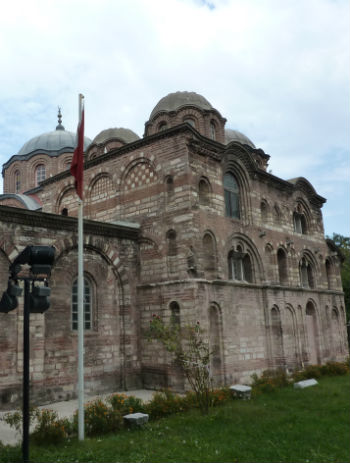
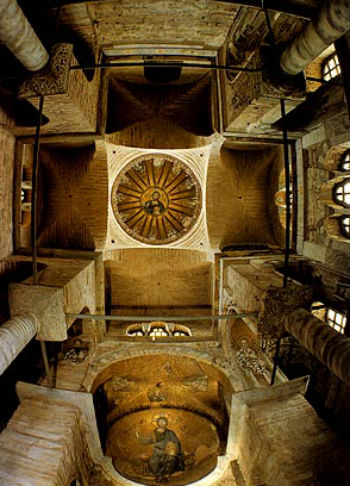
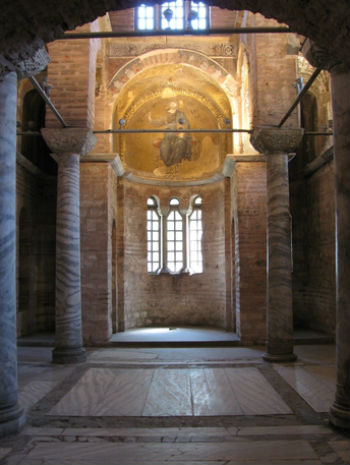
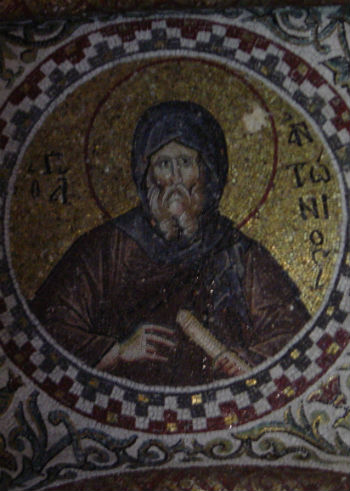
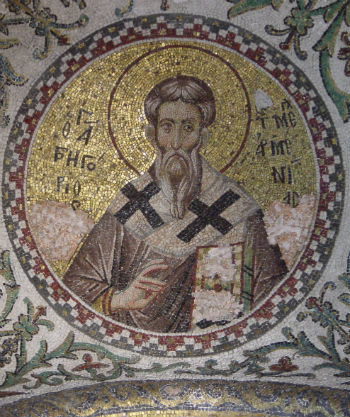
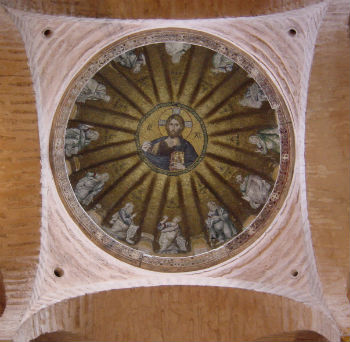


Theotokos Pammakaristos was built in the 13th century and is a fine example of late Byzantine architecture and art. It has been a mosque (called Fethiye Camii) since 1591, but still contains some well-preserved Byzantine mosaics. Worth visiting for any student of Byzantine history.
Even though you can visit only the pareklision (annex of the church) it worth the visit because of the amassing mosaics, excellent examples of Byzantine art. You cannot visit the tomb of Alexios Komninos Emperor or Anna Komnini.
Fethie Mosque/Pammakaristos church is often overlooked by major guidebooks and rarely makes it to traveler’s itinerary. This is partially the beauty of it – unlike the Holy Savior in Chora there is no bustling trade going around, no tourist shops, no restaurants besieging the chapel, no buses arriving every 5 minuets, no honking taxis. In fact for the most part of half an hour that we spent there we had all the splendor of Palaeologan mosaics for ourselves.
Restored is actually only a small chapel – parekklesion, the church itself is still a mosque and is irreparably damaged. Mosaics date from about the same time as mosaics of Holy Savior in Chora (aka Kariye Müzesi), and though parakklesion is much smaller than monumental Holy Savior, I think that some of its mosaics are as impressive as the most interesting mosaics in Chora. In particular, I found extraordinary the Pantocrator that graces the dome of the chapel.
It is about 15 min walk from Pammakaristos to the Holy Savior in Chora so it is logical to combine the two. If you have enough time, I recommend taking taxi to Fethie mosque then walking to Holy Savior and then walking along the Theodosian walls to Ayvansaray doc to take ferry back to Eminonu.
If you are in Istanbul on pilgrimage to see remains of what used to be Constantinople, this is one of the very few places that you must not miss. It is at walking distance from the Chora church ; both places to which you might want to go by taxi (not expensive). Do start with this tiny church, as the Chora church has more to offer. The mosaics are simply splendid (after a good restauration).
The beautiful All-Blessed Mother of God church, has the third largest number of extant Byzantine mosaics in Istanbul, after Chora church and St. Sophia.
As for me, it is much more important than All Istanbul mosques combined. Even if you are in Istanbul for one day, visit Chora and Pammakaristi, skipping all stupid tourist traps such as Topkapi palace or Sultanahmet mosque.
You can only visit the parekklesion, the church itself still functions as a mosque (“Fethiye Jamii”). But even that, with its marvellous architecture, the Pantokrator cupola, and numerous mosaics depicting Saint Grigorios, gives you an idea of the former glory of the place.
It is non-trivial to find the church, though, since it is well-hidden inside a poor and retarded quarter of Western Istanbul, where nobody speaks any English, or whatever Western European language, for that matter (I’ve met some 30 persons, who were able to answer me in Greek, though). Most of the time, I was only person inside, then 2 or 3 other European visitors came.
On a different slope, a visit to this part of the city, where not only ladies, but also males wear full Islamic uniform, would be very illumininating to those, who perceive Turkey as a secular European society.
Mosaics are well preserved. Amazing place !
Pammakaristos Church from Byzantine time… It is similiar to Chora church but smaller and has very fine mosaics remaining from Byzantine times…